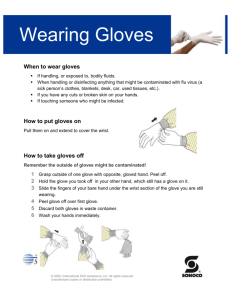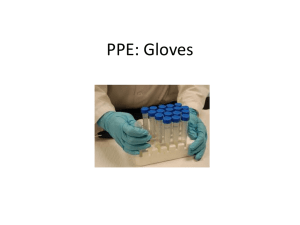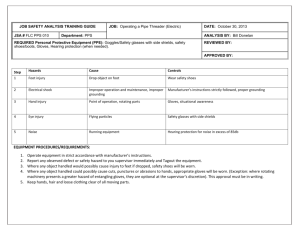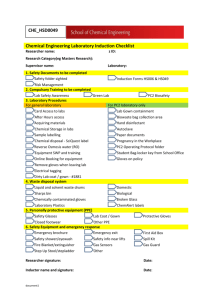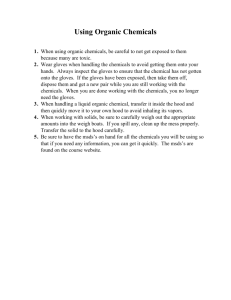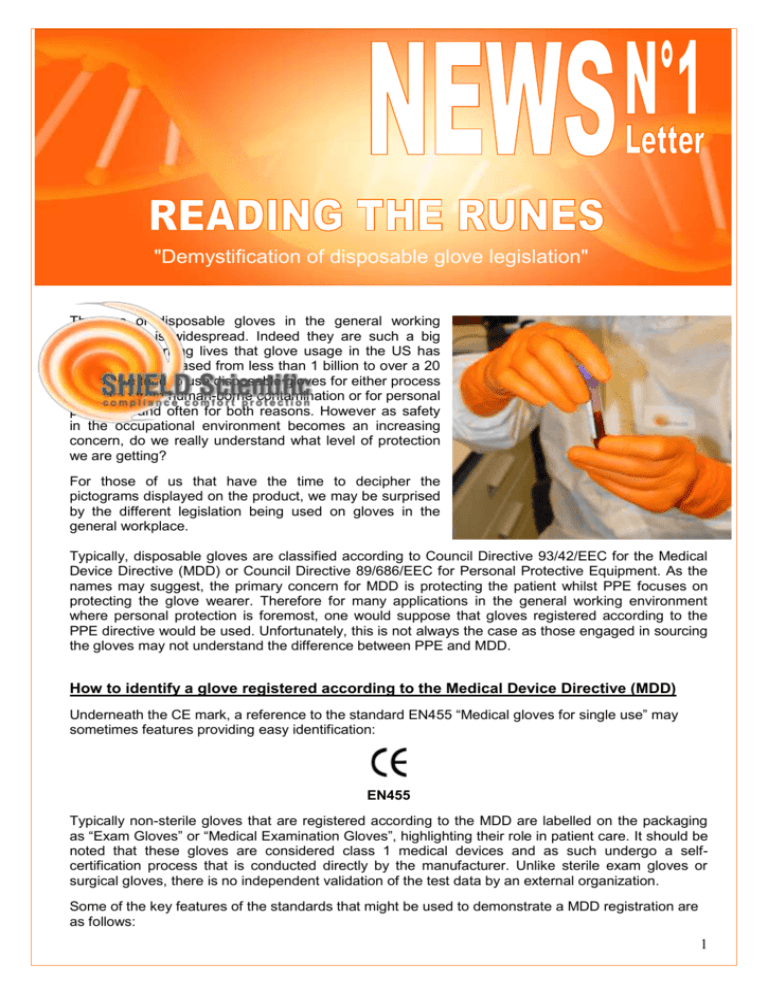
"Demystification of disposable glove legislation"
The use of disposable gloves in the general working
environment is widespread. Indeed they are such a big
part of our working lives that glove usage in the US has
dramatically increased from less than 1 billion to over a 20
billion. We tend to use disposable gloves for either process
protection from human-borne contamination or for personal
protection and often for both reasons. However as safety
in the occupational environment becomes an increasing
concern, do we really understand what level of protection
we are getting?
For those of us that have the time to decipher the
pictograms displayed on the product, we may be surprised
by the different legislation being used on gloves in the
general workplace.
Typically, disposable gloves are classified according to Council Directive 93/42/EEC for the Medical
Device Directive (MDD) or Council Directive 89/686/EEC for Personal Protective Equipment. As the
names may suggest, the primary concern for MDD is protecting the patient whilst PPE focuses on
protecting the glove wearer. Therefore for many applications in the general working environment
where personal protection is foremost, one would suppose that gloves registered according to the
PPE directive would be used. Unfortunately, this is not always the case as those engaged in sourcing
the gloves may not understand the difference between PPE and MDD.
How to identify a glove registered according to the Medical Device Directive (MDD)
Underneath the CE mark, a reference to the standard EN455 “Medical gloves for single use” may
sometimes features providing easy identification:
EN455
Typically non-sterile gloves that are registered according to the MDD are labelled on the packaging
as “Exam Gloves” or “Medical Examination Gloves”, highlighting their role in patient care. It should be
noted that these gloves are considered class 1 medical devices and as such undergo a selfcertification process that is conducted directly by the manufacturer. Unlike sterile exam gloves or
surgical gloves, there is no independent validation of the test data by an external organization.
Some of the key features of the standards that might be used to demonstrate a MDD registration are
as follows:
1
EN455-1
Pinholes based typically on a water leak test on a specified number of gloves.
Compliance to MDD brings the benefit that gloves must meet an Acceptable Quality
Level (AQL) of 1.5 on pinhole defects using an inspection level of G1. An AQL of 1.5
brings a statistical probability that 1.5% of the gloves will have pinhole defects. Whilst
the average is 1.5%, the maximum percentage of gloves allowed to have pinhole
defects in an inspected batch with AQL 1.5 can be as high as 3.17%.
In a hospital environment, the test on pinhole defects is significant in so far as it
indicates the level of barrier protection being offered to the patient.
EN455-2
Physicals covering dimensions and most importantly tensile strength. The latter is
measured in Newtons (N) and assesses the amount of force applied to a glove until it
breaks. For each glove material, EN455-2 provides a minimum standard. For natural
rubber latex exam gloves this is 9N, while for a natural rubber latex surgical glove it is
12N. Tensile strength is relevant, as it measures how materials of the same thickness
respond to pressure. Also significant is that tensile strength is not a requirement of the
PPE directive.
EN455-3
For natural rubber latex gloves, the natural rubber latex protein content must be tested.
Manufacturers may not claim below 50 microgram of water extractable protein.
EN10993-10 As part of EN455-3, a risk assessment needs to be conducted (as defined in EN1441
or EN ISO 14971) to determine the potential of the gloves to cause adverse reactions.
Part of this process may entail testing the gloves for their biological safety (in
accordance with ISO 10993) and particularly with reference to cytotoxicity,
sensitisation and irritation. As sensitisation is a key component of the biocompatibility
of disposable gloves, it may be worth noting that the repeated patch or Buehler test
method is often used for detecting the presence of sensitising chemicals. A more
sensitive method is the maximization test, which combines patch testing with an
adjuvant for the purpose of stimulating an immune response.
How to identify a glove registered according to the Personal Protective Equipment
(PPE) Directive
We have established that for many applications in the general workplace, the focus is on personal
protection and therefore gloves covered by the PPE directive may be the most appropriate. However,
what should we be looking for and how does the PPE directive help us in terms of giving us optimum
protection? In order to assist health & safety personnel engaged in audits to identify the appropriate
PPE to match the hazards and risks, PPE is categorized as Simple Design (often referred to as
Category 1) or Complex Design (Category 3). Intermediate design (Category 2) gloves are those
gloves that do not fall into either complex design or simple design categories.
How can Simple Design gloves help me?
Simple Design is considered to be low risk and as such Simple Design gloves are defined as those
gloves that protect the wearer from cleaning materials of weak action and easily reversible effects.
Gloves giving protection against diluted detergent solutions are given as an example. Apart from
bearing the CE mark, simple design gloves should mention clearly “For minimal risks only” in at least
the official language of the country of destination. Significantly Simple Design is a self-certification
process that imposes no obligation on the manufacturer to conduct tests according to certain
standards. Whilst there is an expectation that the manufacturer will compile a technical file (of which
the key elements might include manufacturing procedures, ISO compliance, quality control systems,
packaging specifications, complaints procedures etc), there is no external validation. From this
description, it would appear that Simple Design gloves may have a limited role in the workplace
where protection from chemicals and micro-organisms is sought.
What additional value do Complex Design gloves bring?
Complex Design covers the highest level of risk, otherwise defined as irreversible and mortal risk.
Disposable gloves in this category are typically those gloves that provide protection against chemical
splashes and micro-organisms. For these gloves the following normative references may apply:
EN374-1 (terminology and performance requirements), EN374-2 (resistance to penetration by
chemicals and micro-organisms), EN374-3 (resistance to permeation by chemicals), EN388
(mechanical risks) and EN420 (general requirements for gloves).
2
Crucially complex design brings the need for regular auditing by an external organization body, called
a Notified Body. The presence of the Notified Body is clearly evident, as under the CE mark will
appear four digits (e.g. 0120 = SGS, 0493=Centexbel, 0321=Satra, 0123=TÜV etc). The Notified
Body validates the quality assurance system used by the manufacturer.
In addition, disposable gloves that have been registered as Complex Design will typically display two
or three pictograms, depending on whether they have been tested according to the 1994 or 2003
versions of the norms relating to the PPE directives:
1994
2003
EN374-3:
Tested for protection
against chemical
permeation
EN374-3
AKL
Low chemical resistant
or waterproof” gloves.
EN388:
Unlikely to be displayed
as few if any disposable
gloves will achieve
performance level rating
of more than zero
Tested for protection
against mechanical risks
(abrasion, blade cut
resistance, tear
resistance & puncture
resistance)
EN374-2:
Tested for protection
against liquid
penetration and microorganisms
EN374-2
Level 2
Instructions for use
Usually incorporated in
the pictogram as “i”
3
Testing for compliance to Complex Design can take two forms: Article 11A “EC quality control system
for the final product” entails testing of samples by the Notified Body and checks at least every year of
the manufacturing facility to ensure homogeneity with the product featured in the EC-type
examination certificate. With Article 11B “System for ensuring EC quality of production by means of
monitoring”, testing may be conducted by the manufacturer but the quality control procedures of the
manufacturer are periodically audited by the Notified Body. These details are important as it may help
to explain why some manufacturers continue to use the 1994 version of the standards relating to the
PPE directive and others the 2003 version. Whilst the Article 11A route obliges the Notified Body to
use the latest norms, there does not appear to be any such obligation for manufacturers selecting the
internal auditing option of Article 11B.
What is the significance of 1994 and 2003 PPE norms for personal protection
The 1994 version of the norms did not differentiate between thin gauge disposable gloves designed
for incidental exposure to chemical splashes and thicker gauge gloves intended for immersion.
Indeed for all the relevant normative references (i.e. EN388, EN374-2 and EN374-3), testing was the
crucial element for achieving registration. With regard to the mechanical risks pictogram (EN388:
1994), few if any disposable gloves would have the necessary properties to achieve anything more
than a performance level rating of “0” for the four specific mechanical tests (resistance to abrasion,
blade cut resistance, tear resistance and puncture resistance). Likewise for chemical permeation
(EN374-3: 1994), selection of the four chemicals to be tested was left to the manufacturer, while the
outcome mattered little so long as the testing had been done. In all cases the “i” on the pictogram
referred the user to more detailed test data displayed on the glove dispenser box. Testing for
protection against liquid penetration and micro-organisms (EN374-2: 1994) gave manufacturers a
choice of levels of pinholes (Acceptable Quality Levels or “AQL” of 4, 1.5 and 0.65), without stating a
minimum level.
In view of the possible confusion between the levels of protection being offered by thin gauge
disposable gloves versus thick gauge gloves, the 2003 version of the standards relating to the PPE
directive imposes more rigorous testing criteria:
EN388: 2003 (protection from mechanical risks) - this pictogram can only be displayed if the glove
achieves a performance level rating of one in at least one of the four specific tests.
EN374-3: 2003 (determination of resistance to permeation by chemicals) – this glass beaker
pictogram
can now only be displayed if a breakthrough time of at least thirty minutes (permeation
performance level: 2) has been achieved in three of the twelve listed chemicals (see table below).
The code letters of the three tested chemicals must now feature below the pictogram. In each
chemical class, it would appear that the most aggressive chemical has been selected giving the glove
wearer a worse case scenario for chemicals in that particular classification. Consequently EN374-3:
2003 represents a significant improvement on the previous version, in terms of its value to those
seeking protection from chemicals. However closer scrutiny of the twelve selected chemicals would
suggest that no standard thin gauge disposable glove in whatever material would achieve the
required level 2 in three out of the twelve listed chemicals.
Code letter
Chemical
CAS N°
A
B
C
D
E
Methanol
Acetone
Acetonitrile
Dichloromethane
Carbon disulphide
67-56-1
67-64-1
75-05-8
75-09-2
75-15-0
F
G
H
Toluene
Diethylamine
Tetrahydrofurane
108-88-3
109-89-7
109-99-9
I
Ethyl acetate
141-78-6
Class
Primary alcohol
Ketone
Nitrile Compound
Chorinated paraffin
Sulphur containing organic
compound
Aromatic hydrocarbon
Amine
Heterocyclic and ether
compound
Ester
4
J
K
L
n-Heptane
Sodium hydroxide
40%
Sulphuric acid 96%
142-85-5
1310-73-2
Saturated hydrocarbon
Inorganic base
7664-93-9
Inorganic mineral acid
To highlight the limitations of the chemical barrier properties of standard thin gauge disposable gloves
and to emphasize that these gloves are designed only for incidental exposure to chemical splashes,
EN374: 2003 has given us a new pictogram
. The question mark in the middle of the squareshaped glass beaker reminds those of us engaged in risk assessments that we are referring to “low
chemical resistant” or “waterproof” gloves. Significantly there is no obligation for the manufacturer to
undertake any testing on the twelve listed chemicals and the new pictogram only tells us that the
gloves have fulfilled the penetration test (EN374-2: 2003). Whilst it is prudent to seek advice from the
manufacturer on actual breakthrough times with a particular chemical, we should not forget that this
test data will often be based on deep immersion of the glove into the chemical and therefore may not
offer a realistic representation of a work situation where the focus is on splash protection. Also it
should be noted that any test data is likely to be done on an unused glove and does not reflect the
actual workplace situation, where the used glove is subjected to many other stresses that are beyond
the scope of a simple laboratory test.
EN374-2: 2003 (determination of resistance to penetration by chemical and/or micro-organisms
through porous material). An important test for those using disposable gloves to protect themselves
from micro-organisms, as it gives us an indication of the barrier properties of the glove to liquid-borne
biohazards. For most disposable gloves, the water leak test is used, where according to the
inspection level based on ISO 2859 a specified number of gloves from every batch are filled with
water to assess the levels of pinholes. Levels of pinholes are measured in terms of AQL or
Acceptable Quality Level, with an AQL of 0.65 having a lower level of acceptable pinholes than 4.0.
To display the pictogram
and as part of the process for satisfying a Complex Design registration,
gloves must have a minimum AQL of 1.5. EN374-2: 2003 describes the levels, which are often
displayed underneath the pictogram:
Performance
level
Level 3
Level 2
Level 1
Acceptable quality level (AQL)
unit
<0.65
<1.5
<4.0
Inspection
levels
G1
G1
S4
More about Complex Design disposable gloves and their use in the general workplace
We have already seen how the 2003 version of the standards relating to the PPE directive represents
a significant evolution in terms of providing greater clarity to glove wearers. However interpretation of
these norms does continue to provide divergence in compliance. Even different Notified Bodies seem
to be able to interpret the norms in different ways, leading to potentially conflicting results. Here are
two examples:
Minimum length of glove
Whilst both the 1994 and 2003 versions of EN420 “General requirements for protective gloves” give
minimum lengths for gloves, various exclusion clauses allow manufacturers to supply shorter lengths
so long as justification is provided. However EN374-1: 2003 makes it clear that for protective gloves
against chemicals and micro-organisms, the minimum length of the liquid proof section of the glove
shall not be less than that specified in EN420. This tightening up of the standard is presumably to
provide extra protection to the wrist. Whilst this change may be entirely laudable, most standard
Complex Design disposable gloves are 24cm or 10”. However, according to EN420 the minimum
length for sizes 9 (L) and 10 (XL) should be respectively 25 cm and 26 cm. This aberration in the
interpretation of the standards even includes gloves claiming registration to the 2003 standards,
where the testing would have been done by a Notified Body as part of the verification process against
Article 11A “EC quality control system for the final product”.
Protection from viral penetration
5
With many personnel increasingly seeking protection from biohazards, clarification on the barrier
protection offered by disposable gloves has become an increasing concern. As we now know, the
micro-organism or liquid penetration pictogram
(as defined in EN374-2: 2003) is the standard to
which we must refer. However, this standard is typically based on the water leak test and may not
provide complete assurance as to the barrier properties of the glove when challenged by a microbial
agent. In this respect clause 3.2 of EN374-1: 2003 states that whilst the test methodology of EN374-2
(2003) is sufficient for demonstrating that the gloves provide an effective barrier to bacteria and fungi,
this does not apply to protection against viruses. Indeed some Notified Bodies are now insisting that
the cautionary statement of “Does not protect against viruses” is included with the general
information. If this is a concern to health & safety personnel, gloves that have undergone the viral
penetration test (ASTM F1671-97b) could be the solution.
Conclusion
We have seen that checking the details on the packaging of our disposable gloves may help to
ensure that we are using the appropriate gloves for use in the general working environment. Whilst
disposable gloves that are registered according to the Medical Device Directive may have some
useful features, these gloves are designed to protect the patient and are not for personal protection.
For many applications in the general workplace where the emphasis is on personal protection from
chemicals and micro-organisms, only those disposable gloves that comply with the Personal
Protective Equipment Directive: 89/686/EEC should be used. In this context, the limitations of Simple
Design gloves and the emphasis on protection from chemical splashes and biohazards would
suggest that those gloves that are Complex Design are the most appropriate.
For further information please contact:
Cisco Robles, MBA
General Manager SHIELD Scientific B.V.
info@shieldscientific.com
Website: www.shieldscientific.com
SHIELD Scientific is a newly founded company that aims to challenge current practices in hand protection, primarily in the laboratory and high
technology sectors. Its brands SHIELDskin™ and duoSHIELD™ achieve this through exceeding expectations in compliance, comfort and protection.
SHIELDskinTM, duoSHIELDTM , ORANGE NITRILE™, ICE NITRILE™ and SKIN NITRILE™ are trade marks of SHIELD Scientific B.V. © 2007
Copyright. All Rights reserved
6

